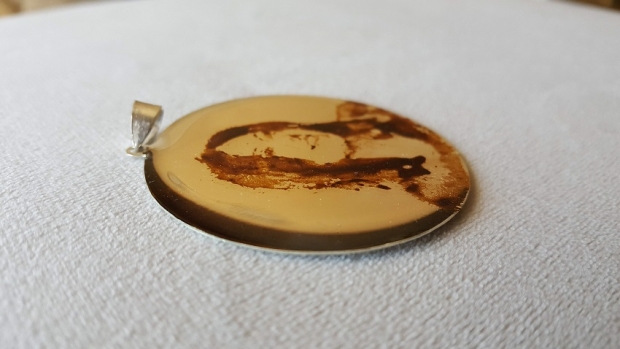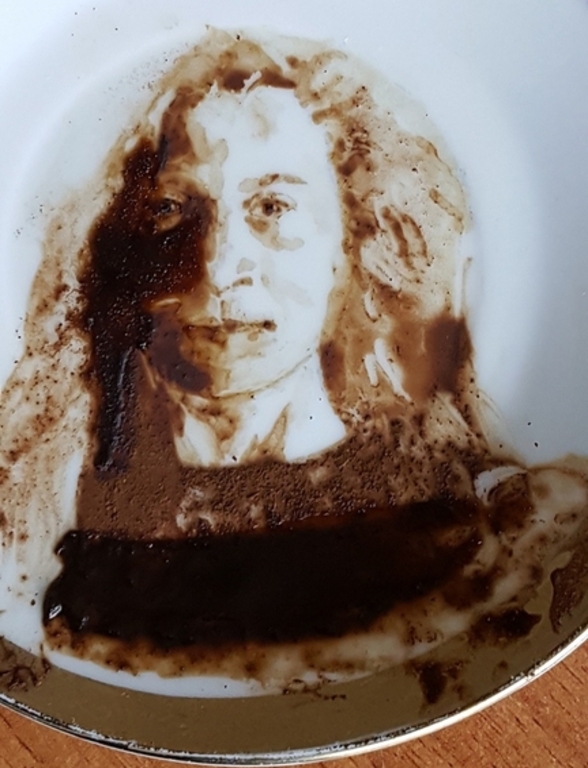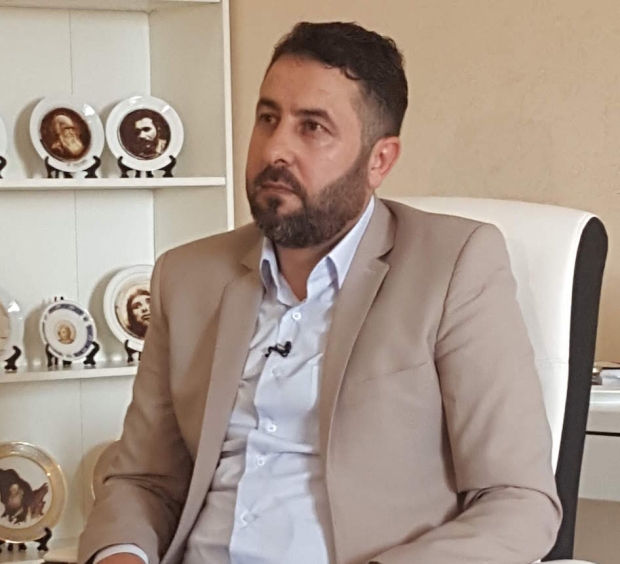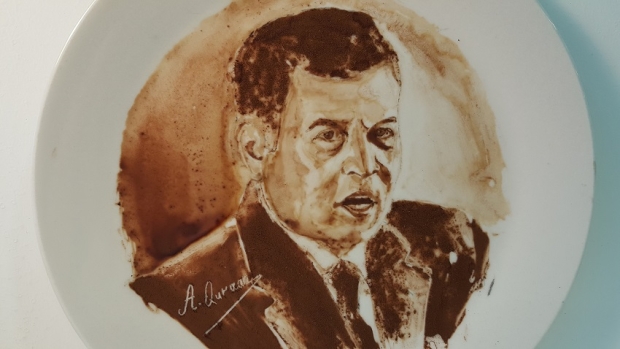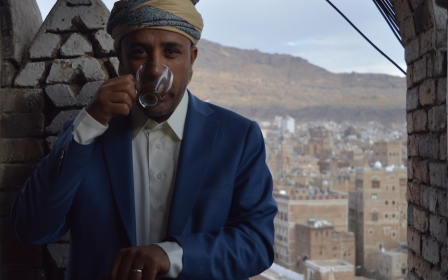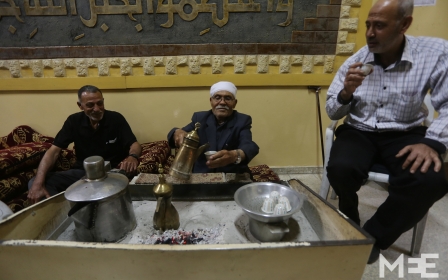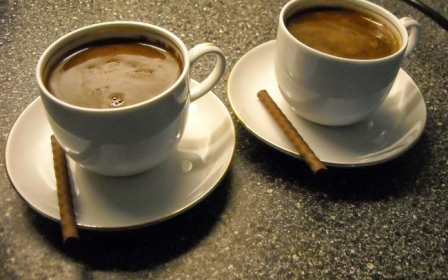Portraits in coffee: Jordanian artist draws life from the cup
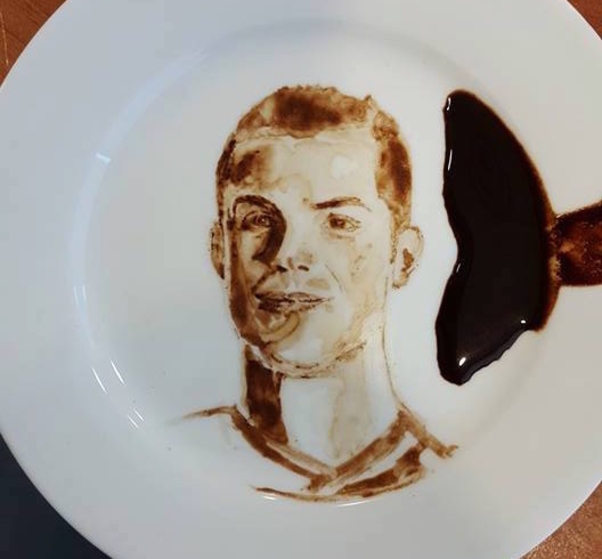
AMMAN - Ahmed al-Quraan was enjoying his morning cup of Turkish coffee in his office in 2017 when his eyes drifted towards his photo displayed on his business card. At the time, he was a supervisor of art at the Arab Open University in Kuwait.
"I decided to play around with coffee. I took my Arabic calligraphy pen and began drawing my own portrait," the 45-year-old Jordanian artist tells Middle East Eye.
Since then he has drawn dozens of portraits of famous figures using coffee, including Palestinian poet Mahmoud Darwish, Charles Darwin, Palestinian activist Ahed Tamimi, the legendary Egyptian singer Umm Kulthum and many more.
"When I draw, I engage with the taste of coffee. I try to make the connection between the taste and the aesthetics before drawing," he explains.
Three shades of coffee
Al-Quraan, who also works as a jewellery designer and owns two jewellery shops, one in Amman and the other in Kuwait, says: "My work with coffee is unique because I draw detailed portraits on very small surfaces."
When I draw, I engage with the taste of coffee. I try to make the connection between the taste and the aesthetics before drawing
- Ahmed al-Quraan, artist
"It sometimes requires more than eight hours of work," he says.
Al-Quraan explains that he uses three shades of coffee colour when painting.
The first and lighter shade comes from the top layer of the coffee, a darker shade of brown comes from the coffee itself, and finally the darkest shade comes from the sediment at the bottom of the Turkish coffee cup.
He also mixes the coffee with different quantities of water to create the different shades, which give his subject a distinctive look.
The artwork of al-Quraan is displayed in his home in the Jordanian capital Amman and has only gone on sale recently, mostly through Facebook and Instagram. He has also decided to accept commissions and create new portraits of customers who express interest.
"Most requests are gifts for birthdays, graduation, weddings ... and they ask me to draw their friends or themselves," he says. "They send the picture and I draw it with coffee."
In October on International Coffee Day, Al-Quraan participated in an exhibition at Majnoon Qahwa, a coffee shop in Kuwait.
Al-Quraan hopes to exhibit all of his drawings in an art exhibition in Amman one day.
Arabic calligraphy
The Jordanian artist also dips wooden pens in coffee to script Arabic calligraphy, producing placards boasting Arabic poetry or phrases from the Quran.
It sometimes requires more than eight hours of work
- Ahmed al-Quraan, artist
"My ability to create Arabic calligraphy has helped me draw. I began practising on wood, then on metal, and then on glass and on coffee cups [in 1998]."
Being a musician also allowed him to explore this connection and merge his musical talent with his Arabic calligraphy skills to create a colourful rhapsody. He later established the Arabic Calligraphy and Music Organisation in 2005 in Amman.
"I used to draw calligraphy and listen to music and that is when I discovered that calligraphy can change as the music changes."
The artist can both draw and play the oud simultaneously, he says. Using his right hand, he paints his creations, while with his left he strums the oud strings. "The combination of both is reflected in my work," he says.
Popular work
Husni Abu Kareem, an artist and dean of arts at Jordan's Zarqa University, has followed al-Quraan's work on social media and has visited his home in Amman. According to Abu Kareen, al-Quraan is in control of his medium.
My ability to create Arabic calligraphy has helped me draw. I began practising on wood, then on metal, and then on glass and on coffee cups [in 1998]
- Ahmed al-Quraan, artist
"One of his most popular works has been the portrait of Ahed Tamimi, whose story of bravery has become a worldwide phenomenon," he says. "He has begun with calligraphy but has moved on to using that genre to create portraits dealing with important figures that are relevant in today's world."
'The mirror of the hand'
At the end of the interview, Al-Quraan quotes Memory For Forgetfulness (1986), the prose poem memoir by Darwish, which was translated into English. The memoir is set during one day of heavy Israeli shelling of Beirut in 1982 after the Israeli invasion of Lebanon.
"Because coffee, the first cup of coffee, is the mirror of the hand. And the hand that makes the coffee reveals the person that stirs it. Therefore, coffee is the public reading of the open book of the soul. And it is the enchantress that reveals whatever secrets the day will bring," Darwish writes.
Al-Quraan says that, like Darwish’s poem, he turns coffee into art and relays the unique traits of his characters.
This article is available in French on Middle East Eye French edition.
New MEE newsletter: Jerusalem Dispatch
Sign up to get the latest insights and analysis on Israel-Palestine, alongside Turkey Unpacked and other MEE newsletters
Middle East Eye delivers independent and unrivalled coverage and analysis of the Middle East, North Africa and beyond. To learn more about republishing this content and the associated fees, please fill out this form. More about MEE can be found here.


